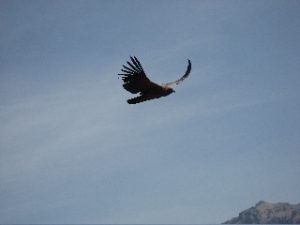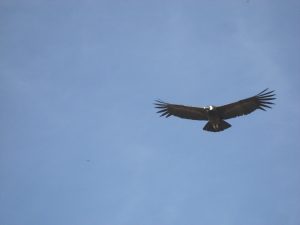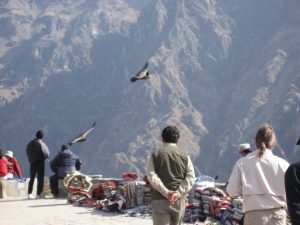The Andean Condor
- Remember, expect this to be challenging.
- First, read the English version.
- Next, read the Spanish version.
- See how many words and phrases you can pick out.
- Make sure to answer the questions to practice your reading comprehension, always using complete sentences.
The Andean Condor
We arrived at Cross of the Condor, Peru, before daybreak. In the chilly predawn, we eagerly awaited the sunrise, for the warming rays would create the thermal uplift that would cue the condors to begin their soaring activities and allow them to scavenge for food for distances of up to 200 miles. Our high outcropping was a perfect place to watch them. As the morning warmed, they began to appear, and even though we had learned a few facts about them, we were unprepared for the impact their presence made upon us.
The experience of having a 30 pound bird with a 10 foot wingspan glide by us was amazing. A member of the vulture family, the condor is the largest flying land bird in the western hemisphere. Once aloft, they rarely flapped their wings. Watching them soar effortlessly across the sun through the blue Andean sky, it was tempting to romanticize them as creatures that lived in complete freedom as they surveyed their domain from heights of up to 18,000 feet. But the reality was much harsher. They must cover vast distances in the hopes of finding a dead animal, such as a
vicuna, a member of the llama family. Often they go for days between meals, and when they find a carcass they eat so much they are sometimes unable to fly afterwards. After eating, they carefully groom their head and neck, which evolved to be featherless to so that they can be sterilized by ultraviolet light and drying winds, which aids in killing the germs that might cling to them after they plunge into a rotting carcass.
To make life even harder, condors have been persecuted by humankind for hundreds of years. Indigenous people have long hunted them because they believe the bone and organs have medicinal powers. Farmers kill them because the erroneously believe that condors kill their livestock. Deforestation and pollution have also decimated their numbers. Though they were added to the endangered species list in 1973, their numbers may still be declining in some parts of South America. Any comeback will be slow because these birds, which can live for 50 years, mate for life, and if the mate is killed, the survivor may not find another mate. Also, condors mate only every few years, and their chicks take 6-7 years to reach sexual maturity. Thus, replenishing their numbers is a slow process. One bright spot is that methods similar to those used to reintroduce the California condor into the wild are being tried in South America with some success. Also, many people are starting to realize that tourists come to see the condors, and if nothing else they have an economic incentive to protect them But this silent bird, which has no voice box, has been revered in South America since at least 2500 B.C. Intertwined with Andean mythology, the condor symbolizes power and health to the indigenous people of the highlands. It was worshiped as a ruler of the upper world, and was related to the sun god of their belief system. I do not believe the Andean people will let this magnificent bird disappear, for they are awakening to the truth that the condor is part of the fabric of their own story. If they let it disappear part of their own soul would die with it. As we watched the condors soar above us, we felt we needed them to remind us to lift ourselves to greater heights so that our spirits may travel further on this earth. Without them, we would be less human and the world would be a lonelier place.
El Cóndor Andino
Llegamos al Cruce del Cóndor, Perú, antes del alba. En las horas frescas que preceden a la madrugada esperamos con emoción la salida del sol, para que los rayos solares creasen el levantamiento térmico que diese la señal a los cóndores de comenzar sus altísimas actividades y de buscar comida a distancias de hasta 200 millas.
Nuestro alto asentamiento era el lugar perfecto para observarles. Según iba calentando la mañana, comenzaron a aparecer, y a pesar de haber aprendido algunos hechos sobre ellos, nos sentimos totalmente desprevenidos para el impacto que nos causó su presencia.
La experiencia de tener un ave de 30 libras y una envergadura de 10 pies de vuelo sobre nosotros fue algo increíble. Miembro de la familia del buitre, el cóndor es el pájaro terrestre volador más grande del hemisferio oeste. Una vez en alto, rara vez aletean. Al observarles remontarse sin esfuerzo a través del sol y a través del azul cielo andino, era tentador romantizarlos como criaturas que vivían en completa libertad mientras inspeccionaban su dominio desde alturas de hasta 18.000 pies. Pero en realidad era más duro. Deben de cubrir vastas distancias con la esperanza de encontrar animales muertos, como una vicuña, de la familia de la llama. A menudo pasan días sin comer, y cuando encuentran un cadáver comen tanto que algunas veces son incapaces de volar después. Tras la comida se limpian con cuidado la cabeza y el cuello, el cual se desplumó con el tiempo con el objetivo de poderse esterilizar con luz ultravioleta y alas de secado, lo cual ayuda a matar los gérmenes que puedan adherirse a ellos después de sumergirse en un cadáver putrefacto.
Y para dificultarles la vida aún más, los cóndores han sido perseguidos por la humanidad durante cientos de años. Las gentes indígenas los han cazado desde hace mucho ya que creen que sus huesos y órganos tienen propiedades medicinales. Los granjeros los cazan bajo la creencia errónea de que matan a su ganado. Y la deforestación y polución también los han diezmado. A pesar de haber sido añadido a las listas de especies en peligro de extinción en 1973, el número de cóndores sigue decreciendo en algunas partes de Sudamérica. El aumento será lento para estos pájaros que pueden llegar a vivir 50 años, se aparejan de por vida, y si la pareja se muere, el superviviente puede que nunca más vuelva a encontrar pareja.
Los cóndores sólo crían cada varios años, y sus polluelos no alcanzan la madurez sexual hasta los 6 o 7 años. Por esta razón el aumento de la especie puede ser un proceso lento.
Una nota alentadora es que métodos similares a los que se usaron para reintroducir el cóndor de California en su medio natural se están llevando a cabo en Sudamérica con éxito. Las gentes de la zona se están dando cuenta de que los turistas vienen a ver los cóndores, y aunque solo por esa razón, tienen un incentivo económico para protegerles.
Este pájaro silencioso, que no tiene caja de voz, ha sido venerado en Sudamérica desde el 2500 A.C. Entrelazados con la mitología andina, el cóndor simboliza poder y salud para las gentes indígenas de las tierras altas. El cóndor era adorado como regente del mundo de las alturas, y se le relacionaba con el dios del sol de su sistema religioso. No creemos que las gentes andinas permitirán que este pájaro desaparezca, ya que se están dando cuenta que el cóndor es parte de su propia historia. Si lo dejan desaparecer, parte de su alma se moriría.
Al observar a los cóndores sobrevolando sobre nosotros, sentimos que los necesitamos para elevarnos a alturas mayores, para que nuestros espíritus viajen más allá de esta tierra. Sin ellos seríamos menos humanos y el mundo sería un lugar más solitario.
Comprensión lectora
- ¿Qué país de Sudamérica es famoso para observar el Cóndor Andino?
- ¿El Cóndor Andino se considera una especie en peligro de extinción?
- Describa algunas de las características del Cóndor Andino.
- ¿Cuáles son algunos de los peligros a los que se enfrenta el Cóndor Andino?





